
A submachine gun (SMG) is a magazine-fed automatic carbine designed to fire handgun cartridges. The term "submachine gun" was coined by John T. Thompson, the inventor of the Thompson submachine gun, to describe its design concept as an automatic firearm with notably less firepower than a machine gun. As a machine gun must fire rifle cartridges to be classified as such, submachine guns are not considered machine guns.
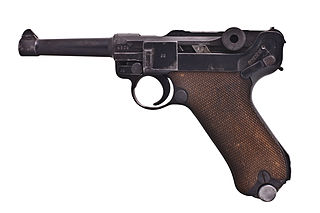
The Pistole Parabellum or Parabellum-Pistole, commonly known as just the Luger or Luger P08, is a toggle-locked recoil-operated semi-automatic pistol. The Luger was produced in several models and by several nations from 1898 to 1949.

The Colt M1911 is a single-action, recoil-operated, semi-automatic pistol chambered for the .45 ACP cartridge. The pistol's formal U.S. military designation as of 1940 was Automatic Pistol, Caliber .45, M1911 for the original model adopted in March 1911, and Automatic Pistol, Caliber .45, M1911A1 for the improved M1911A1 model which entered service in 1926. The designation changed to Pistol, Caliber .45, Automatic, M1911A1 in the Vietnam War era.

The STEN is a British submachine gun chambered in 9×19mm which was used extensively by British and Commonwealth forces throughout World War II and during the Korean War. The Sten paired a simple design with a low production cost, facilitating mass production to meet the demand for submachine guns.

A derringer is a small handgun that is neither a revolver, semi-automatic pistol, nor machine pistol. It is not to be confused with mini-revolvers or pocket pistols, although some later derringers were manufactured with the pepperbox configuration. The modern derringer is often multi barreled, and is generally the smallest usable handgun of any given caliber and barrel length due to the lack of a moving action, which takes up more space behind the barrel. It is frequently used by women because it is easily concealable in a purse or a stocking.

The Mauser C96 is a semi-automatic pistol that was originally produced by German arms manufacturer Mauser from 1896 to 1937. Unlicensed copies of the gun were also manufactured in Spain and China in the first half of the 20th century.
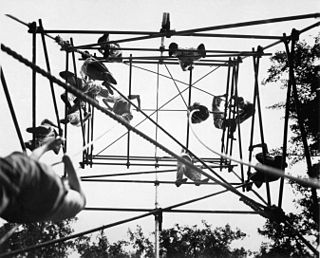
Operation Jedburgh was a clandestine operation during World War II in which three-man teams of operatives of the British Special Operations Executive (SOE), the U.S. Office of Strategic Services (OSS), the Free French Bureau central de renseignements et d'action and the Dutch and Belgian armies in exile were dropped by parachute into occupied France, the Netherlands and Belgium. The objective of the Jedburgh teams was to assist allied forces who invaded France on 6 June 1944 with sabotage and guerrilla warfare, and leading local resistance forces in actions against the Germans.

The .45 ACP, also known as .45 Auto, .45 Automatic, or 11.43×23mm is a rimless straight-walled handgun cartridge designed by John Moses Browning in 1904, for use in his prototype Colt semi-automatic pistol. After successful military trials, it was adopted as the standard chambering for Colt's M1911 pistol. The round was developed due to a lack of stopping power experienced in the Moro Rebellion in places like Sulu. The issued ammunition, .38 Long Colt, had proved inadequate, motivating the search for a better cartridge. This experience and the Thompson–LaGarde Tests of 1904 led the Army and the Cavalry to decide that a minimum of .45 caliber was required in a new handgun cartridge.

The .380 ACP, is a rimless, straight-walled pistol cartridge developed by firearms designer John Moses Browning. The cartridge headspaces on the mouth of the case. It was introduced in 1908 by Colt, for use in its new Colt Model 1908 pocket hammerless semi-automatic, and has been a popular self-defense cartridge ever since, seeing wide use in numerous handguns. Other names for .380 ACP include .380 Auto, 9×17mm, 9mm Browning, 9mm Corto, 9mm Kurz, 9mm Short, and 9mm Browning Court. It should not be confused with .38 ACP. The .380 ACP does not strictly conform to cartridge naming conventions, named after the diameter of the bullet, as the actual bullet diameter of the .380 ACP is .355 inches.

The Heckler & Koch MK 23, MK 23 MOD 0, Mark 23, or USSOCOM MARK 23 is a semi-automatic large-frame pistol chambered in .45 ACP, designed specifically to be an offensive pistol. The USSOCOM version of the MK23 came paired with a laser aiming module (LAM) and suppressor. The USSOCOM MK23 was adopted by the United States Special Operations Command (USSOCOM) for special operations units, beating out the nearest competitor, Colt's OHWS. Development of the pistol began in 1991 as special operations representatives identified the need for an "Offensive Handgun Weapons System—Special Operations Peculiar", and delivery of the pistols began in May 1996 to the special operation units.

The Vis or Vis 35 is a Polish 9×19mm caliber, single-action, semi-automatic pistol. Its design was inspired by the Colt 1911 pistol designed by American John Moses Browning.

Insurgency weapons and tactics (IWAT) are weapons and tactics, most often involving firearms or explosive devices, intended for use by insurgents to engage in guerrilla warfare against an occupier, or for use by rebels against an established government. One type of insurgency weapon are "homemade" firearms made by non-professionals, such as the Błyskawica (Lightning) submachine gun produced in underground workshops by the Polish resistance movement. Another weapon that is part of the conventional military arsenal, but which has been taken up to great effect by insurgents, is the RPG. Two examples of an improvised weapon used by insurgents would be the improvised explosive devices used in Iraq and the Molotov cocktails used against vehicles and tanks. Two tactics used by many insurgents are assassinations and suicide bomb attacks. The latter tactic is used when an insurgent has a bomb strapped to them or in their car, which provides a low-tech way for insurgents to get explosives close to critical enemy targets.

The Vz. 50 is a Czechoslovakian made double-action, semi-automatic pistol. Vz is an abbreviation of the Czech term "vzor" meaning model.

The Remington Model 51 is a small pocket pistol designed by John Pedersen and manufactured by Remington Arms in the early 20th century for the American civilian market. Remington manufactured approximately 65,000 Model 51 pistols in .32 ACP and .380 ACP calibers from 1918 to 1926, though small numbers were assembled into the mid-1930s.

The M1917 Revolvers were six-shot, .45 ACP, large frame double action revolvers adopted by the United States Military in 1917, to supplement the standard M1911 pistol during World War I. There were two variations of the M1917, one made by Colt and the other by Smith & Wesson. They used moon-clips to hold the cartridges in position, facilitate reloading, and to aid in extraction since revolvers had been designed to eject rimmed cartridges and .45 ACP rounds were rimless for use with the magazine-fed M1911. After World War I, they gained a strong following among civilian shooters. A commercial rimmed cartridge, the .45 Auto Rim, was also developed, so M1917 revolvers could eject cartridge cases without using moon-clips.
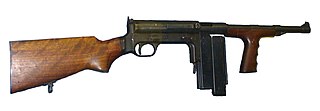
The United Defense M42, sometimes known as the Marlin for the company that did the actual manufacturing, was an American submachine gun used during World War II. It was produced from 1942 to 1943 by United Defense Supply Corp. for possible issue as a replacement for the Thompson submachine gun and was used by agents of the Office of Strategic Services (OSS). However, its usage was limited, and the Thompson continued to see service until the end of the war, alongside the M3 submachine gun, which was designed around the same time as the M42.
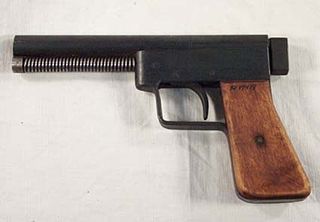
Improvised firearms are firearms manufactured other than by a firearms manufacturer or a gunsmith, and are typically constructed by adapting existing materials to the purpose. They range in quality from crude weapons that are as much a danger to the user as the target to high-quality arms produced by cottage industries using salvaged and repurposed materials.
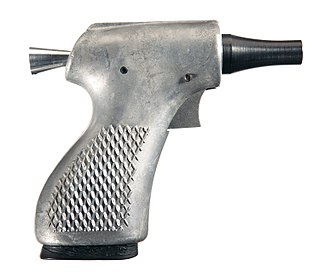
The Deer gun, developed by the CIA, was a successor to the Liberator pistol. The single-shot Deer gun was intended for distribution to South Vietnamese guerrillas as a weapon against North Vietnamese soldiers.

A handgun is a firearm designed to be usable with only one hand. It is distinguished from a long gun which needs to be held by both hands and braced against the shoulder. Handguns have shorter effective ranges compared to long guns, and are much harder to shoot accurately. While most early handguns are single-shot pistols, the two most common types of handguns used in modern times are revolvers and semi-automatic pistols, although other handguns such as derringers and machine pistols also see infrequent usage.

The Liberator is a 3D-printable single-shot handgun, the first such printable firearm design made widely available online. The open source firm Defense Distributed designed the gun and released the plans on the Internet on May 6, 2013. The plans were downloaded over 100,000 times in the two days before the United States Department of State demanded that Defense Distributed retract the plans.






















